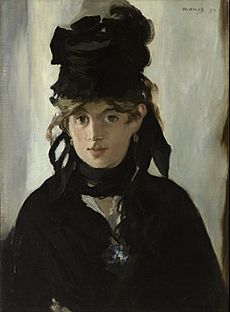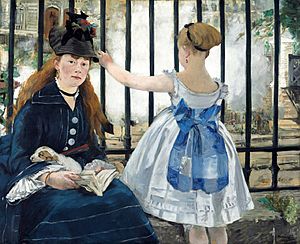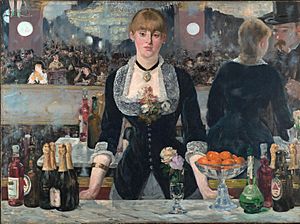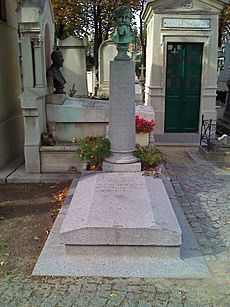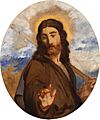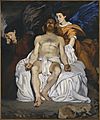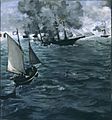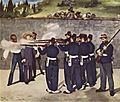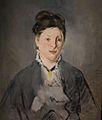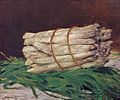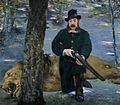Édouard Manet facts for kids
Quick facts for kids
Édouard Manet
|
|
|---|---|

Édouard Manet before 1870
|
|
| Born | 23 January 1832 |
| Died | 30 April 1883 (aged 51) Paris, France
|
| Resting place | Passy Cemetery, Paris |
| Education | Collège-lycée Jacques-Decour, Académie Suisse |
| Known for | Painting, printmaking |
|
Notable work
|
|
| Movement | Realism, Impressionism |
| Spouse(s) |
Suzanne Leenhoff
(m. 1863) |
Édouard Manet (born January 23, 1832 – died April 30, 1883) was a famous French painter. He was one of the first artists in the 1800s to paint scenes from everyday modern life. Manet was a very important artist who helped change painting styles from Realism to Impressionism.
Manet was born into a wealthy family in Paris. His family wanted him to join the navy, but he loved painting instead. His early famous paintings, The Luncheon on the Grass and Olympia, both painted in 1863, caused a lot of discussion. These paintings became important for the young artists who later started the Impressionist movement. Today, these works are seen as the beginning of modern art. In the last 20 years of his life, Manet became friends with other great artists. He developed his own simple and direct painting style. This style was seen as very new and influenced many painters who came after him.
Contents
Manet's Early Life and Training
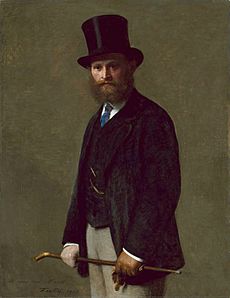
Édouard Manet was born in Paris on January 23, 1832. His family was rich and well-known. His mother, Eugénie-Desirée Fournier, was the daughter of a diplomat. She was also the goddaughter of the Swedish crown prince. Manet's father, Auguste Manet, was a judge. He wanted Édouard to become a lawyer. But Manet's uncle, Edmond Fournier, encouraged him to paint. His uncle often took young Manet to the Louvre Museum to see art.
In 1845, Manet started a special drawing class. There he met Antonin Proust, who would become a lifelong friend. Proust later became the Minister of Fine Arts in France. In 1848, Manet sailed on a training ship to Rio de Janeiro. He tried twice to join the French Navy but failed the exams. After this, his father finally let him study art. From 1850 to 1856, Manet studied with a painter named Thomas Couture. In his free time, Manet copied paintings by old masters at the Louvre.
From 1853 to 1856, Manet traveled to Germany, Italy, and the Netherlands. During these trips, he was inspired by the Dutch painter Frans Hals. He also admired the Spanish artists Diego Velázquez and Francisco José de Goya.
Manet's Art Career
In 1856, Manet opened his own art studio. In this period, his paintings had loose brush strokes. He simplified details and used fewer in-between colors. He followed the realism style that Gustave Courbet had started. Manet painted The Absinthe Drinker (1858–59). He also painted everyday subjects like beggars, singers, and people in cafés.
Later in his career, he rarely painted religious or historical scenes. However, in 1864, he painted Jesus Mocked by the Soldiers and The Dead Christ with Angels. In 1861, two of Manet's paintings were accepted into the Salon. The Salon was the official art exhibition in Paris. A portrait of his parents was not liked by critics. But The Spanish Singer was admired by the writer Théophile Gautier. It became popular with visitors to the Salon. Manet's style seemed "slightly slapdash" compared to other detailed Salon paintings. But it made many young artists curious. The Spanish Singer was painted in a "strange new fashion" that surprised many painters.
Music in the Tuileries
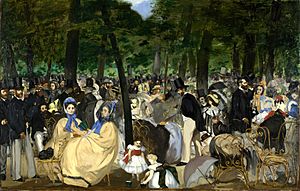
Music in the Tuileries is an early example of Manet's painting style. He was inspired by Hals and Velázquez. This painting shows his interest in painting scenes of people enjoying their free time.
Some people thought the painting looked unfinished. But it captures the feeling of the Tuileries gardens at that time. You can almost imagine the music and conversations happening there.
In this painting, Manet included his friends. These were other artists, writers, and musicians. He even painted a self-portrait among the people in the scene.
Luncheon on the Grass
A very important early painting by Manet is The Luncheon on the Grass. The Paris Salon rejected this painting in 1863. But Manet decided to show it at the Salon des Refusés. This was a special exhibition for paintings that the official Salon had rejected. Emperor Napoleon III created the Salon des Refusés. This was because the Salon had rejected many paintings that year.
For this painting, Manet used Victorine Meurent as a model. His wife Suzanne, his future brother-in-law Ferdinand Leenhoff, and one of his brothers also posed. Victorine Meurent also posed for other important Manet paintings, like Olympia. By the mid-1870s, she became a skilled painter herself.
Manet's Life and Friends
After his father died in 1862, Manet married Suzanne Leenhoff in 1863. Suzanne was a piano teacher from the Netherlands. She was two years older than Manet. They had been together for about ten years. Suzanne had first been hired by Manet's father to teach Manet and his younger brother piano. In 1852, Suzanne had a son, Leon Koella Leenhoff.
Manet painted his wife in The Reading and other works. Her son, Leon Leenhoff, often posed for Manet. He is famously shown in Boy Carrying a Sword (1861). He also appears as the boy with a tray in the background of The Balcony (1868–69).
Manet became friends with the Impressionist painters. These included Edgar Degas, Claude Monet, Pierre-Auguste Renoir, Alfred Sisley, Paul Cézanne, and Camille Pissarro. He met them through another painter, Berthe Morisot. She was part of their group and brought him into their activities. This group later became known as the Batignolles group.
Berthe Morisot was a talented painter. Her first painting was accepted into the Salon de Paris in 1864. She continued to show her work there for ten years.
Manet and Morisot became close friends and colleagues in 1868. She helped convince Manet to try plein air painting. This means painting outdoors, which she had learned from Camille Corot. They influenced each other's art. Manet used some of her techniques in his paintings. In 1874, Morisot married Manet's brother, Eugène.
Unlike the main Impressionist group, Manet believed artists should try to show their work at the Paris Salon. He did not want to abandon it for independent shows. However, when his work was not chosen for the International Exhibition of 1867, he held his own exhibition. His mother worried he would spend all his money on this expensive project. The exhibition received bad reviews from critics. But it helped him meet several future Impressionist painters, like Degas.
Manet's own art influenced the Impressionist style. But he did not want to be part of their group exhibitions. He preferred to show his work at the Salon. Eva Gonzalès was his only official student.
The Impressionists, especially Monet and Morisot, influenced Manet. You can see this in his use of lighter colors. After the early 1870s, he used dark backgrounds less often. But he kept his unique use of black, which was not typical for Impressionist painters. He painted many outdoor scenes. However, he always returned to what he considered the serious work of his studio.
Manet was good friends with the composer Emmanuel Chabrier. Manet painted two portraits of him. Chabrier owned 14 of Manet's paintings. He also dedicated a piece of music to Manet's wife.
In the early 1880s, Manet often painted Méry Laurent. She was a well-known figure in Parisian society. Laurent posed for seven of his pastel portraits. Her home was a meeting place for many French writers and painters. Manet gained connections and influence through these gatherings.
Throughout his life, art critics often did not like Manet's work. But he had supporters like Émile Zola, Stéphane Mallarmé, and Charles Baudelaire. These writers publicly defended him. They encouraged him to paint life as it truly was. Manet, in turn, drew or painted each of them.
Paintings of Paris Life
Manet's paintings of café scenes show what social life was like in 19th-century Paris. He painted people drinking, listening to music, talking, reading, or waiting. Many of these paintings were based on quick sketches he made on the spot. Manet often visited the Brasserie Reichshoffen. He used it as the setting for At the Cafe in 1878. In this painting, people are at the bar. One woman looks directly at the viewer.
These paintings are like a visual diary of a "flâneur." A flâneur was someone who walked around the city, observing everything. Manet's style in these works is loose. It reminds us of Hals and Velázquez. Yet, they perfectly capture the feeling of Parisian nightlife. They are like painted snapshots of city life. They show working people and some of the wealthy people too.
In Corner of a Café-Concert, a man smokes while a waitress serves drinks behind him. In The Beer Drinkers, a woman enjoys her beer with a friend. In The Café-Concert, a well-dressed gentleman sits at a bar. A waitress stands in the background, sipping her drink. In The Waitress, a serving woman pauses. A customer smokes a pipe, and a ballet dancer is on stage in the background.
Manet also painted at Pere Lathuille's restaurant on the Avenue de Clichy. This restaurant had a garden. One painting he made there was Chez le père Lathuille. It shows a man who is interested in a woman dining nearby, but she doesn't seem to notice him.
In Le Bon Bock (1873), a large, happy man with a beard sits. He holds a pipe in one hand and a glass of beer in the other. He looks straight out at the viewer.
Paintings of Social Activities
Manet also painted the upper class enjoying more formal social events. In Masked Ball at the Opera, Manet shows a lively party crowd. Men in top hats and black suits talk to women in masks and costumes. He included portraits of his friends in this painting.
His 1868 painting The Luncheon was set in the dining room of the Manet family home.
Manet painted other popular activities. In The Races at Longchamp, he used an unusual view. This helps show the fast energy of racehorses as they rush towards the viewer. In Skating, Manet shows a well-dressed woman in the front. Other people skate behind her. There is always a feeling of active city life happening behind the main subject. This makes it seem like the scene continues beyond the painting's edge.
In View of the International Exhibition, soldiers relax. Wealthy couples are talking. There is a gardener, a boy with a dog, and a woman on horseback. It shows a mix of different people from Paris.
Manet and War
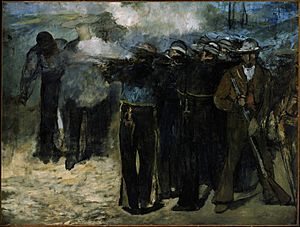
Manet also painted about war. These works can be seen as modern versions of "history paintings." His first such painting was The Battle of the Kearsarge and the Alabama (1864). This was a sea battle during the American Civil War. It happened off the French coast. Manet might have seen it himself.
Next, he was interested in France's involvement in Mexico. From 1867 to 1869, Manet painted three versions of The Execution of Emperor Maximilian. This event raised questions about French foreign policy. The different versions of The Execution are among Manet's largest paintings. This shows that he thought the topic was very important. It shows the execution of a Habsburg emperor by a Mexican firing squad. This emperor had been put in power by Napoleon III. Neither the paintings nor a print of the subject were allowed to be shown in France. These paintings criticize violence. They look back to Goya's work and look forward to Picasso's Guernica.
Manet also created a watercolour painting called The Barricade. It shows soldiers executing members of the Paris Commune. This was based on his earlier print of Maximilian's execution.
Manet admired the politician Léon Gambetta. In 1877, Manet opened his art studio for a political meeting. This meeting was led by Gambetta's friend Eugène Spuller.
Paintings of Paris Streets
Manet painted many scenes of the streets of Paris. The Rue Mosnier Decked with Flags shows red, white, and blue flags covering buildings. Another painting with the same title shows a one-legged man walking with crutches. He also painted the same street in a different way in Rue Mosnier with Pavers. This painting shows men repairing the road while people and horses pass by.
The Railway, also known as The Gare Saint-Lazare, was painted in 1873. It shows the city landscape of Paris in the late 1800s. Manet used his favorite model, Victorine Meurent, for the last time in this painting. She also modeled for Olympia and The Luncheon on the Grass. In this painting, she sits in front of an iron fence. She holds a sleeping puppy and an open book. Next to her is a little girl with her back to the painter. The girl is watching a train pass below them.
Instead of a natural background, Manet chose an iron fence. This fence "boldly stretches across the canvas." The only sign of the train is its white cloud of steam. In the distance, you can see modern apartment buildings. This arrangement brings the foreground into a tight focus. It ignores the traditional idea of deep space in painting.
When this painting was first shown in 1874, people were confused. Critics found its subject strange and its composition messy. But today, it is seen as a symbol of modern times. The painting is now in the National Gallery of Art in Washington, D.C.
Manet painted several boating scenes in 1874. Boating, now in the Metropolitan Museum of Art, is a good example. It shows how Manet learned from Japanese prints. The way the boat and sail are cut off by the edge of the painting makes the image feel very immediate.
In 1875, a French version of Edgar Allan Poe's The Raven was published. It included prints by Manet and was translated by Mallarmé.
In 1881, Manet's friend Antonin Proust helped him. The French government gave Manet the Légion d'honneur. This is a very high award in France.
Manet's Later Works
In his mid-forties, Manet's health got worse. He had severe pain and partial paralysis in his legs. In 1879, he started getting water treatments at a spa. He thought he had a problem with his blood flow. But he was actually suffering from a nerve disease. In 1880, he painted a portrait of the opera singer Émilie Ambre there.
In his last years, Manet painted many small still lifes. These showed fruits and vegetables. Examples include A Bunch of Asparagus and The Lemon (both 1880). He finished his last major work, A Bar at the Folies-Bergère, in 1882. It was shown at the Salon that year. After this, he only painted small pictures. His very last paintings were of flowers in glass vases.
Manet's Death
In April 1883, doctors had to remove his left foot because of a serious infection. He died eleven days later, on April 30, 1883, in Paris. He is buried in the Passy Cemetery in the city.
Manet's Legacy
Manet's public career lasted from 1861 until his death in 1883. He created many artworks. These include 430 oil paintings, 89 pastels, and over 400 works on paper.
Critics often strongly disliked Manet's work. They said it lacked a traditional "finished" look. But some people admired his art from the beginning. One of them was Émile Zola. In 1867, Zola wrote that Manet's paintings were "simple and direct." He also called them "luminous and serious."
Manet's rough painting style and bright lighting were seen as very modern. They challenged the older Renaissance artworks he sometimes copied. He stopped using the old method of building up layers of paint on a dark background. Instead, he used a direct, alla prima method. This meant painting with opaque paint on a light background. This new method allowed him to finish a painting in one sitting. The Impressionists adopted this technique. It became the main way of painting with oils for many years. Manet's work is considered "early modern." This is partly because his painted surfaces often look flat. He also used quick, sketch-like parts and black outlines for figures. All these things draw attention to the painting's surface and the paint itself.
Art historians say Manet is seen as the "Father of Modernism." He was one of the first artists to take risks with the public. He was also one of the first to make alla prima painting a standard technique. He dared to change traditional perspective. He offered "pure painting" as a source of beauty. Manet was a pioneer, along with Courbet. They rejected old-fashioned historical subjects. He also helped make modern city life an acceptable topic for serious art.
Art Market
A late painting by Manet, Le Printemps (1881), was sold for $65.1 million to the J. Paul Getty Museum. This set a new record for a Manet painting sold at auction in 2014. The previous record was for Self-Portrait With Palette, which sold for $33.2 million in 2010.
Images for kids
-
The Spanish Singer, 1860 Metropolitan Museum of Art
-
The Old Musician, 1862, National Gallery of Art
-
Mlle. Victorine in the Costume of a Matador, 1862, Metropolitan Museum of Art
-
The Philosopher, (Beggar with Oysters), 1864–67, Art Institute of Chicago
-
The Ragpicker, 1865–70, Norton Simon Museum
-
Young Flautist, or The Fifer, 1866, Musée d'Orsay
-
Still Life with Melon and Peaches, 1866, National Gallery of Art
-
The Tragic Actor (Rouvière as Hamlet), 1866, National Gallery of Art
-
Woman with Parrot, 1866, Metropolitan Museum of Art
-
The Guitar Player, c. 1866, Hill-Stead Museum
-
Portrait of Émile Zola, 1868, Musée d'Orsay
-
The Balcony, 1868–69, Musée d'Orsay
-
Masked Ball at the Opera House, 1873, National Gallery of Art
-
Boating, 1874, Metropolitan Museum of Art
-
Portrait of Abbé Hurel, 1874, National Museum of Decorative Arts, Buenos Aires
-
The grand canal of Venice (Blue Venice), 1875, Shelburne Museum, Vermont
-
Madame Manet, 1874–76, Norton Simon Museum, Pasadena
-
Portrait of Stéphane Mallarmé, 1876, Musée d'Orsay
-
The Plum, 1878, National Gallery of Art
-
At the café, 1878, Sammlung Oskar Reinhart 'Am Römerholz', Winterthur
-
The bar, 1878–79, Pushkin Museum
-
Pertuiset, the lion hunter, 1881, Museu de Arte, São Paulo
-
House in Rueil, 1882, National Gallery of Victoria, Melbourne
-
Flowers in a Crystal Vase, 1882, National Gallery of Art
-
Carnations and Clematis in a Crystal Vase, 1883, Musée d'Orsay
See also
 In Spanish: Édouard Manet para niños
In Spanish: Édouard Manet para niños
- List of paintings by Édouard Manet
- Realism
- Hispagnolisme
- Portraiture
- History of painting
- Western painting


